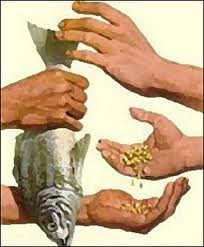Nothing To Lose
I was reading this article about a
so-called “healing priest” and it struck me that even in the 21st century,
people are still gullible enough to trust “faith healers.”
There are a lot of reasons for
this (poverty and miseducation among them), but in this day and age, you’d think that people would think twice about trusting those who claim to heal all kinds
of diseases through prayers and faith alone. Mind you, the “healers” would make
it clear that their healing powers did not come from them, but from a “higher
power.” These mysterious power source would range from the Baby Jesus (or the adult one), “Mama Mary,”
from a magical dwarf (I’m not kidding), a mysterious hermit, or even from an old
lady who claims to be a reincarnation of Jesus.
Filipinos lap these up. Even today, there are many people in the country's rural areas that still believe in anting-anting (amulets). It’s not a coincidence
that people in areas that are mired in poverty and with low literacy rates are
the ones that have the most superstitious beliefs. But even those who are
supposed to be college-educated also believe in all sorts of anting-antings and
in the supernatural and the paranormal.
Like these faith healers. Although many had been revealed as nothing but con men and charlatans, they are still flourishing in this country. What's more, they
do not lack for patrons, even from those who are "educated," and from
the middle class.
Maybe it’s also a cultural thing? The inhabitants of the Philippines after all practiced a form of animism and other indigenous beliefs during pre-colonial times. Believing in magic healers is not that too great a leap for a people who, until now, believe in kulam.
There are also those who turn to faith healers as a result of desperation. "What have we get to lose?" is often what they tell themselves to justify their decision to trust these sleazy purveyors of false hopes. But it is this attitude, this desperation, that these con men count on.
And, it pains me to admit this, our inherent gullibility.
There are also those who turn to faith healers as a result of desperation. "What have we get to lose?" is often what they tell themselves to justify their decision to trust these sleazy purveyors of false hopes. But it is this attitude, this desperation, that these con men count on.
And, it pains me to admit this, our inherent gullibility.
Reading about this healing priest reminded me of James Randi’s Paranormal Challenge,
where a million dollars is offered “to
anyone who can demonstrate a supernatural or paranormal ability under
agreed-upon scientific testing criteria.”
James Randi, a stage magician,
enemy of charlatans, and a "debunker" of fantastic claims, had said:
"There exists in society a very special class of persons that I have always referred to as the Believers. These are folks who have chosen to accept a certain religion, philosophy, theory, idea or notion and cling to that belief regardless of any evidence that might, for anyone else, bring it into doubt. They are the ones who encourage and support the fanatics and the frauds of any given age. No amount of evidence, no matter how strong, will bring them any enlightenment. They are the sheep who beg to be fleeced and butchered, and who will battle fiercely to preserve their right to be victimized."
The challenge was
first offered in 1964, and so far, no one has won the prize.
The article I linked
above is about the aborted deal between one of the country’s top corporations
and the foundation headed by a certain Father Fernando Suarez, a “healing
priest.” The deal was about a 33 hectare land in Cavite (a province a few
kilometers south of Manila) to be donated to Fr. Suarez’s foundation.
A Catholic priest, Fr.
Suarez had planned to build a giant statue of Mary on the donated land, a
statue that, if built, will rival Rio de Janeiro’s Christ the Redeemer in terms
of size. This giant statue would reportedly cost about a billion Philippine
Pesos (around 22 million USD).
The Philippines is
among the poorest countries in the world, and is often ravaged by typhoons and
other natural disasters. A statue that would cost this much to build in a
country like ours is nothing short of obscene.
This is not just your
run-of-the-mill religious devotion; this is fanaticism of the nauseating kind.





Comments
Post a Comment
So, what do you think? Post it here: